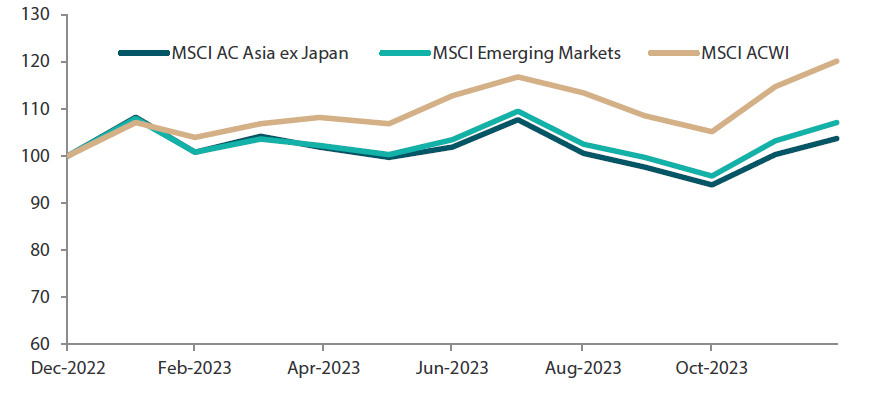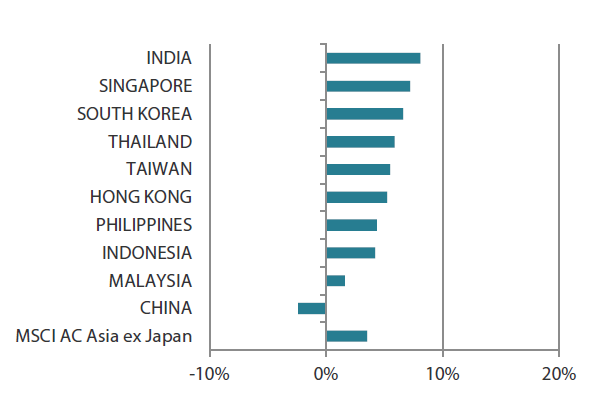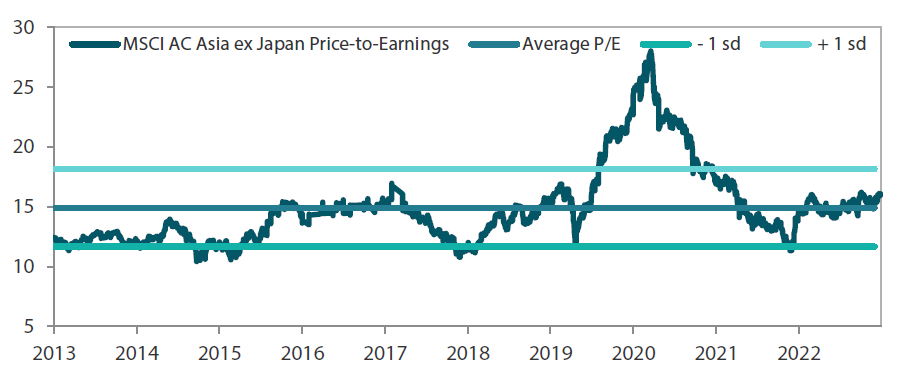Summary
- The peaking of interest rates and potentially the US dollar could be a boon for broader markets—particularly those more sensitive to liquidity, countries with more room to ease rates and areas where positive fundamental changes have been overlooked. China’s economy is undergoing a major transition into one that promotes advanced manufacturing, technology (tech), self-sufficiency and higher-end overseas growth. These are areas of our focus.
- For the month, the MSCI AC Asia ex Japan Index climbed 3.5% in US dollar (USD) terms. The index gained amid growing optimism over future monetary easing as the US Federal Reserve (Fed) left interest rates unchanged and sent its clearest message yet that its aggressive hiking campaign has ended by projecting a series of rate cuts in 2024.
- India (+8.1%), Singapore (+7.2%) and South Korea (+6.6%) led the gains in December, whereas China (-2.4%) and Malaysia (+1.6%) were the notable laggards.
- Beyond China, we believe that some of the best sustainable return opportunities lie in India and Indonesia, where positive reforms are occurring, and Taiwan and South Korea, which represent globally competitive North Asian exporters.
Market review
Asian markets gain in December
Regional equities, barring China, ended 2023 with robust gains in December, with the MSCI Asia ex Japan Index climbing 3.5% in USD terms. Investor sentiment was boosted as the Fed left interest rates unchanged for a third straight meeting and sent its clearest message yet that its aggressive hiking campaign has ended by forecasting a series of rate cuts in 2024. Several Asian economies could follow suit by lowering interest rates in 2024.
Chart 1: 1-yr market performance of MSCI AC Asia ex Japan vs. Emerging Markets vs. All Country World Index

Source: Bloomberg, 31 December 2023. Returns are in USD. Past performance is not necessarily indicative of future performance.
Chart 2: MSCI AC Asia ex Japan versus Emerging Markets versus All Country World Index price-to-earnings

Source: Bloomberg, 31 December 2023. Returns are in USD. Past performance is not necessarily indicative of future performance.
China bucks the uptrend seen in regional markets
China stocks declined 2.4% in December. Its massive gaming industry was dealt a blow by new proposals to curb the amount of time and money spent on video games, raising concerns that regulators are once again cracking down heavily on the sector. China’s economic recovery remains patchy as industrial production beat expectations but retail sales fell short of forecasts. The country’s consumer price index contracted for the third month in 2023, dropping 0.5% year-on-year (YoY) in November as the world’s second-largest economy grapples with worsening deflation. Authorities also relaxed home buying restrictions in Beijing and Shanghai, extending efforts introduced in major cities to aid the housing market. Hong Kong stocks fared better, gaining 5.3% in December.
South Korea stocks rose 6.6% as exports increased 7.8% YoY in November, driven by a rebound in semiconductor demand, which boosted optimism for the country’s economic outlook and global trade in 2024. The country’s semiconductor industry registered the largest gains in years in both production and shipments—chip production soared 42% YoY in November, while shipments spiked 80%. Taiwan stocks also performed well, climbing 5.5%, as export orders grew for the first time in more than a year. Taiwan’s central bank also kept rates on hold, citing expectations of easing inflation.
ASEAN markets notch up gains
In the ASEAN region, Singapore and Thailand were the best performing markets in December, with returns of 7.2% and 5.9%, respectively. The Philippines, Indonesia and Malaysia made respective gains of 4.4%, 4.2% and 1.6%. Singapore’s key exports returned to growth for the first time in over a year in November, as non-oil domestic exports rose 1% YoY, largely due to favourable base effects. Thailand saw its consumer prices fall for a second straight month in November due to state subsidies for energy and lower food prices. In the Philippines, the central bank maintained its policy rate steady at 6.5% in December, saying that policy would have to stay "sufficiently tight" to bring inflation back to target. Indonesia likewise left its benchmark seven-day reverse repurchase rate at 6% in December to support the rupiah and keep inflation at bay but indicated there was room for monetary easing in the second half of 2024. Malaysia's inflation rate continued to ease, slowing to 1.5% YoY in November from 1.8% in October.
Indian equities outperform
For the month, Indian stocks jumped 8.1% as the Reserve Bank of India in December raised its GDP growth forecast to 7% from 6.5% for the current fiscal year through March 2024 and decided to the keep policy rate unchanged at 6.5% for the fifth consecutive time. India's retail inflation rose sharply to 5.55% in November on an annual basis. India’s ruling Bharatiya Janata Party won three key state elections—unseating the opposition in two of them—strengthening Prime Minister Narendra Modi’s bid for a third term in office.
Chart 3: MSCI AC Asia ex Japan Index1
| For the month ending 31 December 2023 | For the year ending 31 December 2023 | |

|

|
Source: Bloomberg, 31 December 2023.
Market outlook
Peak interest rates a boon for broader markets
As we look to the year ahead, we must first focus on some of the key characteristics of 2023—banking crises (which involved regional banks in the US and Credit Suisse in Europe), fundamental changes in tech from generative AI, pro-growth policy in China and the potential peaking of interest rates globally. The peaking of interest rates and potentially the US dollar could be a boon for broader markets—particularly those more sensitive to liquidity, countries with more room to ease rates and areas where positive fundamental changes have been overlooked.
In Asia, some of these countries are likely to be twin deficit economies where positive reform is also occurring, namely India and Indonesia. Areas more sensitive to liquidity conditions that have been pressured in recent years include renewables. They also include innovation across multiple segments such as healthcare and in tech (outside of AI, which had already done well on account of the earnings uplift in 2023 to many in the hardware and infrastructure supply chain).
China pivots towards advanced manufacturing, tech, self-sufficiency and higher-end overseas growth
In China, pro-cyclical policy is clearly back, but it has so far has failed to address the main issues holding back the domestic economy and markets, namely the property sector and consumer confidence. The release of a rather stringent draft policy in the e-gaming sector in late December did little to quell concerns over China’s investability. While the release of the e-gaming sector draft policy was likely mistimed, we would point to this being part of a broader effort to encourage offline activity and spending. Directed consumption remains the case as it has always been in China. Looking more broadly, China is clearly going through another major economic transition—from an economy that reduces the role of property and services to one that promotes advanced manufacturing, tech, self-sufficiency and higher-end overseas growth. These are areas of our focus.
Asia’s other bright spots offering opportunities for sustainable returns
While there are understandable concerns about China, we should not overlook the bright opportunities that other parts of Asia offer. We continue to highlight that some of the best sustainable return opportunities lie in India and Indonesia, where positive reforms are occurring, and Taiwan and South Korea, which represent globally competitive North Asian exporters. At the sector level, we would also highlight the healthcare industry where several positive factors are starting to fall into place, namely much more appealing valuations, lighter positioning, supportive policy and the second wave of biosimilar development. Asia is well placed to capture these opportunities.
We must also be mindful of some of the risks and areas of potential negative fundamental change ahead. An already significant amount of rate cuts have been priced in by markets and without further economic weakness, these may be subject to change. China is yet to stabilise both its property market and economy convincingly although supportive policy action is increasing. We also have a very busy electoral calendar in 2024, kicking off with Taiwan in January before elections take place in India, Indonesia and finally the US towards the end of the year. Geopolitical risk is here to stay, which has both positive and negative implications for investors. Managing these risks will be key to delivering sustainable returns in Asian equities, in our view.
Chart 4: MSCI AC Asia ex Japan price-to-earnings

Source: Bloomberg, 31 December 2023. Ratios are computed in USD. The horizontal lines represent the average (the middle line) and one standard deviation on either side of this average for the period shown. Past performance is not necessarily indicative of future performance.
Chart 5: MSCI AC Asia ex Japan price-to-book

Source: Bloomberg, 31 December 2023. Ratios are computed in USD. The horizontal lines represent the average (the middle line) and one standard deviation on either side of this average for the period shown. Past performance is not necessarily indicative of future performance.
1Note: Equity returns refer to MSCI indices quoted in USD. Returns are based on historical prices. Past performance is not necessarily indicative of future performance.
Reference to individual stocks is for illustration purpose only and does not guarantee their continued inclusion in the strategy’s portfolio, nor constitute a recommendation to buy or sell.



